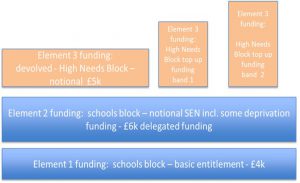Funding for SEN in Mainstream

Most children and young people with special educational needs and disabilities will have the support that they need from within the school or setting’s budgets.
There are three levels or ‘elements’ of funding for education support for children and young people with special educational needs.
- Element 1 funding makes provision for every child or young person on roll in an early years setting, school or college. It pays for the school building, class teachers, etc.
- Element 2 funding is a part of the budget in schools and further education settings that is especially for children with additional needs, including special educational needs and disabilities. The government has said that a mainstream school or college has up to £6,000 to spend on each child with additional needs from within the school or setting’s budget, if they need extra help to be able to make progress. This is sometimes called ‘delegated funding’ and it is for schools to provide early intervention support, which may include, for example, small group or individual support or special equipment. Schools are able to use this in the best way to meet needs in that school and for the children or young people on their roll.
- Element 3 funding– if a child or young person with special educational needs and disabilities has been receiving early intervention support but are still not making sufficient progress, it is possible that they will need to access element 3 funding. This is also called ‘top-up’ funding. There is more information about element 3 funding in the next section.
In Camden, the local authority has ensured that all Camden nursery, primary and secondary schools (including free schools and academies), have more than the first £6,000 element 2 funding so that they can make provision up to £11,000 for pupils where their assessments show they need that level of support, without the need to access top-up funding through an EHC plan. This does not apply to Children’s centres, independent early years settings, or FE colleges, which receive funding in a different way.
Schools have access to other funding. For example, any school where children are eligible for free school meals will also receive ‘pupil premium’ money to spend on improving the rate of progress those children. This is because there is a gap in educational attainment between the group of children receiving free school meals and the majority of children who do not. Across the country, there is a significant overlap between children eligible for free school meals and having special educational needs.
In addition, there is a range of other early intervention support that schools and settings can access that they do not need to fund themselves. Examples include health therapies or family support work. Each service will make their own assessment that determines the level of support offered from that service.
If a child needs more provision than can be provided through the local offer available in schools, the early years setting, school or college will ask for an Education, Health and Care (EHC) needs assessment to consider whether the child or young person needs an EHC plan. If a plan is issued, it will describe what resources are attached to the plan.
This may include additional money on top of the school’s budget, called ‘element 3’ or ‘top-up’ funding. It is a ‘top-up’ as it is in addition to the element 2 funding (the first £6,000) that the school or setting already receives. It is personalised funding as it allocated to named individual children or young people. The funding will usually be attached to an EHC plan, with some exceptions.

The High Needs Block is money provided by the government to fund education provision for Camden children and young people aged 0-25 with more complex special educational needs and disabilities when they attend education settings.
The High Needs Block funds:
- Where a Camden resident child or young person aged 0-25 years attends education provision and needs more support than the school or setting is expected to pay for, they may be allocated ‘top up’ (sometimes called ‘element 3’) funding. This includes the funding for EHC plans and is for Camden children and young people wherever they attend a school or setting. This funding will follow the child if they move to a different school of a similar type. The amount of top-up might increase or decrease, for example if a child’s needs change, or they go to a different type of school or setting.
- The place costs (elements 1 and 2, see above for an explanation) in pupil referral units, resource bases in schools and special schools in Camden for the agreed number of places.
- Enhanced nursery places or specialist resourced provision in schools.
- Some additional services or teams providing support to individual children and young people, such as outreach teams or early years specialists.





